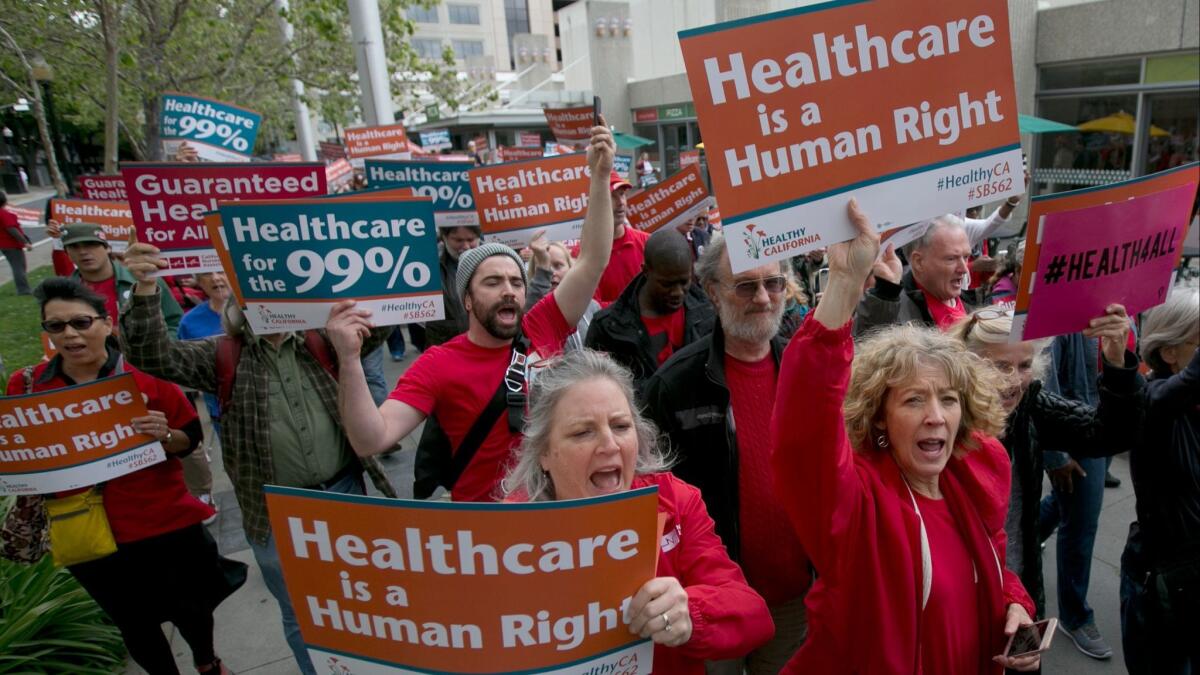Column: Finally, a universal healthcare proposal that would work for everyone

- Share via
Up to now, single-payer and universal health coverage proposals in the U.S. have foundered on one shoal or another: They’re ungodly expensive; they replace plans that people like; they’re too sudden; they’re not sudden enough; they’re politically impossible, etc., etc., etc.
But now take a look at “Medicare Extra for All.” It’s a universal coverage proposal released last week by the Center for American Progress, a progressive think tank associated with the Democratic Party.
It’s not quite “Medicare for All,” to cite the mantra used by Sen. Bernie Sanders (I-Vt.) and others who want a near instantaneous, wholesale transformation of the American health coverage system into a public service. Instead, it would preserve privately financed employer coverage for as long as employers want to stay in.
The lesson Democrats have learned politically is that they’re alone.... Democrats will be much more ruthless the next time around.
— Health economist Harold Pollack.
But within a few years it would become “Medicare for Most,” as healthcare commentator Andrew Sprung observes. That’s because newborns and those turning 65 would automatically be enrolled, along with everyone buying insurance in the individual market and all uninsured people, including legally resident noncitizens. Eventually, Medicaid and CHIP, the Children’s Health Insurance Program, would be folded in.
The proposal addresses many of the flaws of the Affordable Care Act, most of which could have been addressed routinely by Congress over the last seven years, if Republicans were interested in improving health coverage for their constituents instead of riding the ideological hobby horse of Obamacare repeal.
Medicare Extra confronts the reasons for the high cost of the American healthcare system head-on by placing caps on doctor and physician reimbursements, reducing administrative costs, and negotiating with drug and medical device companies. It doesn’t treat the drivers of high costs as some sort of opaque mystery requiring the genius of Jeff Bezos, Warren Buffett and Jamie Dimon to unravel—because they’re not a mystery.
That brings us to the politics of the plan. Plainly, it goes nowhere in a Republican-dominated Congress. If Democrats win control, however, Medicare Extra for All must be considered the best template for completing the transformation of the dysfunctional American health coverage system begun by the Affordable Care Act and reversing GOP sabotage of the ACA and Medicaid.
Extra also may be the only chance Democrats have to resist opposition by stakeholders in the present system, such as physicians, hospitals, drug makers and medical device manufacturers.
“The lesson Democrats have learned politically is that they’re alone,” health economist Harold Pollack observed at healthinsurance.org. “They’re not going to get Republican support. They’re not going to get stakeholder support for some of the most critical things.” Following seven years of sabotage by the GOP, he predicted, “Democrats will be much more ruthless the next time around.”
Let’s examine the most important elements of Medicare Extra for All.
In addition to the automatic enrollment of newborns and the uninsured, everyone legally resident in the U.S. would be eligible for Extra: Traditional Medicare, Medicare Advantage, employer coverage and federal programs for military families, veterans or government employees would remain in place, but their enrollees could switch to Extra if they wished.
Extra would provide free preventive care, free treatment for chronic disease and free generic drugs, as well as services deemed essential by the Affordable Care Act such as hospitalization, prescriptions, maternity care and mental health and substance abuse treatment. It also would cover dental, vision and hearing services. Enrollees could choose from any doctor or hospital participating in Medicare, which is most of them.
Premiums and co-pays would be charged on a sliding scale. For households with income up to 150% of the federal poverty line — $18,210 for individuals and $37,650 for a family of four — there would be no premium or deductible. From there to 500% of the poverty level — $60,700 for one, $125,500 for four — premiums would be capped in a range rising with income, but no higher than 10% of income. Over 500%, the 10% premium cap would apply.
As we’ve reported recently, this would solve one of the most irritating aspects of the ACA — the sudden cutoff of premium subsidies for families making 400% of the poverty line, which means one dollar in additional earnings can result in a loss of all subsidies.
With the exception of employer plans, commercial insurers would be barred from duplicating Medicare Extra, though they could offer other benefits — cosmetic surgery coverage, for instance. That’s wise, because U.S. employers currently provide coverage to 152 million Americans, paying $485 billion in annual premiums. Those that continued their plans could keep the tax deduction they get on those costs.
Or they could shift their employees to Medicare Extra by contributing at least 70% of the premium or making lump-sum payments to the government. They’d lose the tax break in those cases, however. Employers with fewer than 100 full-time workers wouldn’t have to make the payments.
Medicare Extra would save money by setting provider rates roughly at an average of Medicaid, Medicare and commercial reimbursement rates, which the drafters say would end up somewhat higher than Medicare but lower than commercial rates. Primary care doctors would get a bump up in reimbursements relative to specialists, to reduce the incentives for excessive specialty referrals.
Medicare Extra would have the authority to negotiate prices with drug companies and medical device and equipment manufacturers. The system, moreover, would cut administrative costs sharply by paring the role of commercial insurers — a boon to doctors and hospitals that have to spend heavily to manage claims.
The program still would need more revenue than what currently goes to Medicare, Medicaid and other government healthcare programs. The Center for American Progress proposes to raise at least some of it by taking back some of the tax cut giveaway to corporations and the wealthy enacted by the Republicans in December. Among the options are a surtax on high-income taxpayers, including a higher tax on capital gains.
This could include eliminating the step-up in capital gains basis enjoyed by families that bequeath their capital assets to the next generation. Under current law, this allows wealthy taxpayers to extinguish the tax on their capital gains permanently, an utterly unjustified handout to the rich. Healthcare tax breaks could also be reduced for higher-income taxpayers. Finally, excise taxes on cigarettes and sugared drinks could be raised to generate more income.
Health insurance expert Charles Gaba estimates that Medicare Extra could enroll 25 million to 30 million people immediately and then absorb enrollees who become dissatisfied with their employer plans because of rising premiums and deductibles, among other reasons.
Gaba is right to observe that Medicare Extra, as drafted, will tick off the fewest number of stakeholders in the present system while scaling up to “achieve universal coverage within eight years of being passed … which is about as quickly as anyone could reasonably expect it to happen.”
It’s not single-payer, exactly, but only single-payer dead-enders could object to its payer provisions. It’s the best solution to the realities, politics and drawbacks of the U.S. health insurance system yet to appear, and the time to start pushing it is now.
Keep up to date with Michael Hiltzik. Follow @hiltzikm on Twitter, see his Facebook page, or email michael.hiltzik@latimes.com.
Return to Michael Hiltzik’s blog.
More to Read
Sign up for Essential California
The most important California stories and recommendations in your inbox every morning.
You may occasionally receive promotional content from the Los Angeles Times.














